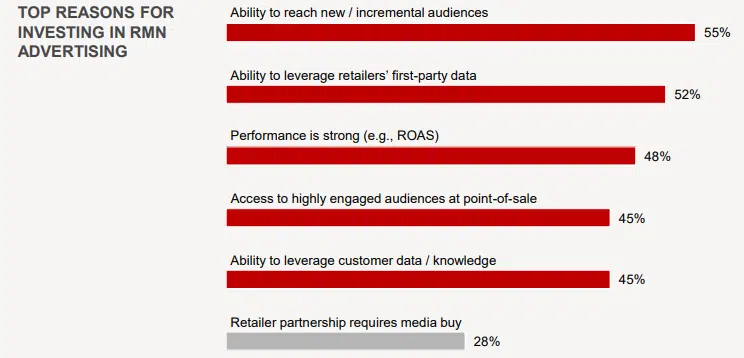IAB releases new guidelines as retail media networks mature
Advertisers say they’ll increase RMN investment but they want standardization, a new study from the IAB finds.
The IAB introduced new guidelines to improve measurement across retail media networks (RMNs) this week. The guidelines will be open for public comment through October 13.
The guidelines will be welcomed by advertisers and agencies set to increase RMN ad spend, especially if the industry is more standardized. Nearly two-thirds of ad buyers (62%) cited the lack of measurement standards as a top challenge to continued growth, a new IAB study found. Both the guidelines and the study were released at the inaugural IAB Connected Commerce Summit: Retail Reimagined event in New York.
Why we care. RMNs are attractive to advertisers because of the deep knowledge retailers have about their customers. However, advertisers and agencies need to be able to compare across networks and measure the impact of campaigns in RMNs against outside channels in order to prove the investment is worth it.
Personalization and consumer insights. The value of RMNs is evident to brands that don’t have the same level of purchase data and other insights that retailers have. First-party data for personalization is also harder to come by with more privacy regulations and the phasing out of third-party cookies.
“Marketers have lost a lot of signals with third-party cookies and identifiers, so RMNs allow brands to really bring back personalization and that connection that brands really want to have with consumers, especially on the CPG (consumer packaged goods) side, where brands are starting to build out first-party data — but there’s still a long way to get there,” said Jeffrey Bustos, vice president, measurement addressability data with the IAB.
“RMNs provide the ability for brands to understand customer insights, develop messaging and, most importantly, provide closed-loop measurement,” Bustos said. “Obviously it’s getting more difficult to measure things, and RMNs enable the ability to understand the impact of media on outcomes.”
Guidelines. The IAB collaborated with the Media Rating Council (MRC) to create the IAB/MRCRetail Media Measurement Guidelines. The guidelines focus on four key areas:
- Transparency and consistency: Clear definitions and methodologies should be the norm, enabling stakeholders to easily compare metrics.
- Accuracy and reliability: Employ robust methodologies and technologies designed to minimize errors and adapt to evolving landscapes.
- Privacy and security: Comply with privacy regulations like GDPR and CCPA and implement stringent security measures to protect user data.
- Compliance with industry standards: Align with best practices as established by MRC, IAB, and other industry bodies.
Data accuracy. Key guidelines around data quality and accuracy aim at ensuring advertisers’ confidence in RMN campaign reporting. The guidelines recommend that RMN measurement tools and methodologies are regularly calibrated and validated (annually, at a minimum). RMNs should also maintain consistent data collection processes for both internal and audit purposes.
Additionally, RMNs are referred to IAB Tech Lab’s Spiders and Bots List to filter out invalid traffic. RMNs are also encouraged to compare data against known benchmarks to identify and correct potential biases and inaccuracies.
In-store measurement. The guidelines cover measurement for digital channels, as well as in-store digital place-based (DPB) environments. For instance, in-store zones must be established at the physical location in order to attribute foot traffic and sensor data to specific screens where ads are shown.
While the new guidelines break down how retailers can apply taxonomy and measurement to visual, as well as audio, ads, RMNs are referred to the MRC Digital Place-Based Audience Measurement Standards for further guidance about exposure and ad impressions in physical locations.
Challenges to RMN growth. Nearly 70% of RMN buyers said “complexity in the buying process” was the biggest obstacle to the growth of RMNs, according to the IAB study of 200 advertisers and agencies who spend $5 million or more annually in RMNs. Additionally, 60% called “transparency” a challenge for RMNs.
Increasing budgets. These advertisers estimate they will increase their RMN budget, on average, by 11% this year over 2022. Advertisers spending between $30 million and $60 million said they’d increase their spend, on average, by 15%.
To fund the increase in RMN spend, brands are reallocating funds from digital platforms, and traditional media non-advertising “shopper/trade marketing,” according to the study.
Top reasons for RMN advertising. Here’s a look at the top reasons that advertisers gave for making their investment in RMNs.

Notably, only 28% of those surveyed said that the retailer partnership required the media buy.
Dig deeper: What brands and retailers need to know about RMNs
Related stories